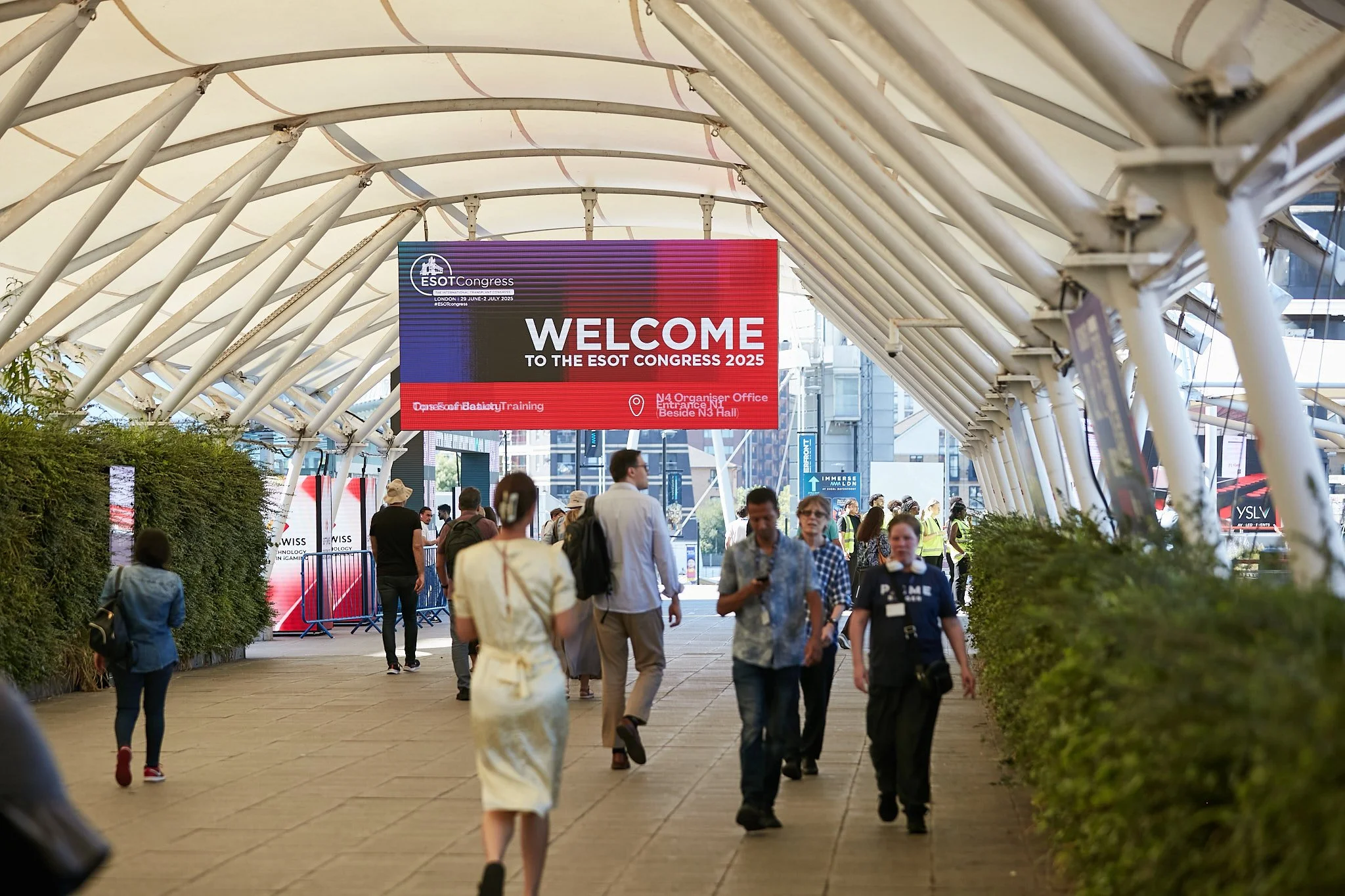
ESOT Congress Daily Recap
Tuesday 1 July 2025
Scientific Programme Highlights: New study reveals 33% gap in transplant access for UK’s poorest children
New research, presented today at the congress, has revealed persistent inequalities in children’s access to life-saving kidney transplants across the UK. The study highlights how ethnicity, socioeconomic status, and gender significantly influence a child's likelihood of receiving a transplant.
Researchers from the University of Bristol analysed national data from the UK Renal Registry and NHS Blood & Transplant, focusing on patients under 18 years who started kidney replacement therapy between 1996 and 2020. Their findings reveal concerning disparities in access to transplant waitlists and to both deceased and living donor kidney transplants.
Early on in their treatment, children from Black and Asian communities, girls, and those living in extremely low-income areas are frequently less likely to be placed on the transplant waitlist or receive a transplant. Compared to children from wealthier families, children from the lowest-income families have a 33% lower chance of being placed on the waiting list. Similarly, girls have a 12% lower chance of being added to the waitlist than boys.
“We were particularly struck by how early these disparities appear in the transplant process,” said Dr. Alice James, lead author of the study. “It’s not just about who gets a transplant, but who even gets considered in the first place.”
These disparities can have profound consequences. Delays or lack of access to transplantation, especially pre-emptive transplants, prolong children’s reliance on dialysis, which is associated with increased morbidity, poorer growth outcomes, cognitive delays, and reduced quality of life.
International comparisons show that these issues are not unique to the UK. Similar disparities in paediatric kidney transplant access have been documented in the United States, Canada, and Australia, particularly among Indigenous and ethnic minority populations.
Scientific Programme Highlights: Side-to-side duodenoduodenostomy delivers low complication rates in pancreas transplantation
Leonardo Da Vinci Award Nominee: Rongrong Hu Zhu
A single-centre series using duodenoduodenostomy for exocrine drainage reported a 10% intestinal complication rate and 86.7% graft survival at 5 years, with no perioperative mortality.
Effective exocrine drainage remains a key determinant of success in pancreas transplantation, and duodenoduodenostomy (DD) offers a physiologic alternative that replicates native pancreatic anatomy. In a single-centre study conducted between May 2016 and November 2024, 170 pancreas transplants were performed using a side-to-side DD technique, anastomosing the donor duodenum to the recipient’s antimesenteric duodenum.
The median recipient age was 43 years (IQR 36–39), and median cold ischemia time was 8 hours (IQR 6.1–10.1). Intestinal complications occurred in 10% of cases, including paralytic ileus (n=5), intestinal occlusion (n=4), DD dehiscence (n=5), post-transplantectomy duodenal dehiscence (n=1), and anastomotic bleeding (n=2). Eleven cases (6.5%) required surgical intervention, including adhesiolysis, primary closure, redo of the enteric anastomosis, transplantectomy, and one Hartmann’s procedure. No perioperative mortality was reported.
At a median follow-up of 39.8 months (IQR 18.1–69), pancreas graft survival was 86.7% at one, three, and five years, and patient survival reached 100%, 99.2%, and 99.2%, respectively.
These findings support side-to-side DD as a safe and effective exocrine drainage technique in pancreas transplantation, offering durable outcomes with a manageable complication profile. Broader multicentre studies are warranted to confirm reproducibility across centres.
Transcriptomics reveals PVAN-like abnormalities in BK viremia and identifies candidate drugs for repurposing
Leonardo Da Vinci Award Nominee: Alexis Piedrafita
Whole-transcriptome analysis distinguishes PVAN from normal and TCMR biopsies, reclassifies low-level BK viremia cases, and highlights potential therapeutic targets.
Polyomavirus-associated nephropathy (PVAN) remains a serious post-transplant complication lacking precise diagnostic tools and effective treatment. Using RNA-seq on 78 BK virus-positive kidney biopsies (26 PVAN, 52 isolated BK viremia), researchers identified 3,572 differentially expressed genes compared to normal samples.
Functional analyses highlighted dysregulated pathways in inflammation, metabolism, and cell cycle regulation. Cell deconvolution revealed increased infiltration of plasma cells, CD8⁺ and CD4⁺ T cells (including follicular helper and memory subsets), NK cells, and both M1 and M2 macrophages in PVAN biopsies, indicating a broad immune response.
PCA analysis confirmed that PVAN cases form a distinct transcriptomic cluster, with 10 isolated BK viremia samples (regardless of viral load) clustering with PVAN. This suggests that current BK viremia thresholds may miss underlying PVAN-like pathology.
Additionally, a drug repurposing analysis using the Connectivity Map identified candidate compounds capable of antagonising the PVAN transcriptomic signature. These findings support the use of transcriptomics to refine PVAN diagnosis and uncover therapeutic opportunities.
OX118: A fully human anti-OX40L antibody that suppresses effector T cells and expands Tregs
Leonardo Da Vinci Award Nominee: Robin Fröbom
OX118 significantly reduced CD4⁺ and CD8⁺ T-cell proliferation while enriching CD4⁺CD25⁺FOXP3⁺ regulatory T cells in mixed lymphocyte reactions, and fully protected mice from graft-versus-host disease (GvHD), with 100% survival at day 56, minimal chimerism, and durable disease control.
Co-stimulatory signalling through OX40/OX40L is critical for full T-cell activation, and its inducible nature makes it an attractive target for immune modulation. OX118 is a fully human, ADCC-enhanced monoclonal antibody designed to block OX40L with high potency and selectively modulate immune responses. In allogeneic mixed lymphocyte reactions, OX118 suppressed CD4⁺ and CD8⁺ T-cell proliferation to 15.6% and 20.2% of control levels, respectively, outperforming benchmark agents including Belatacept, oxelumab (IgG1), and amlitelimab (IgG4). Importantly, OX118 induced a dose-dependent expansion of CD4⁺CD25⁺FOXP3⁺ regulatory T cells, reaching 43% of the proliferating CD4⁺ pool compared to 8.8% in controls—a feature not replicated by other agents, with only modest effects observed for oxelumab and none for amlitelimab or Belatacept. In parallel, it reduced bystander activation across natural killer cells, B cells, and CD14⁺ monocytes, suggesting a targeted immunomodulatory profile with limited off-target immune activation.
In a humanised xenogeneic GvHD model, OX118 conferred complete protection from clinical disease. Treated animals maintained body weight, exhibited <1% human CD45⁺ cell chimerism by day 35 (versus ~33% with IgG4 anti-OX40L), and showed reduced human leukocyte infiltration across tissues. GvHD clinical scores remained low through day 56, indicating sustained disease control. All control animals died by day 39, while 100% of OX118- and amlitelimab-treated animals survived through study completion. No adverse clinical signals were observed, and weight gain inversely correlated with disease scores, supporting OX118’s tolerability.
These findings highlight OX118 as a first-in-class, ADCC-optimised anti-OX40L antibody with dual immunomodulatory activity. By suppressing effector T-cell proliferation and expanding regulatory T-cell populations, OX118 offers a compelling approach to costimulation blockade and has now entered Phase 1 clinical evaluation for autoimmune and alloimmune indications.
Viral infection reactivates NK cell rejection of hypoimmune SC-islets via NKG2D ligands
Leonardo Da Vinci Award Nominee: Raniero Chimienti
Triple-knockout stem cell-derived islets resist immune attack under sterile conditions but become vulnerable to natural killer (NK)-mediated cytolysis following viral challenge, due to infection-induced expression of NKG2D-activating ligands.
Stem cell-derived pancreatic islets engineered to lack MHC-I, B7-H3, and CD155 (triple knockout, T-KO) evade both T cell and NK cell-mediated rejection under homeostatic conditions, representing a promising strategy for universal islet replacement in type 1 diabetes. However, the effect of viral infection on NK cell activation and graft tolerance remains undefined. To investigate this, luciferase-expressing T-KO islets were transplanted into diabetic mice, followed by NK cell humanisation on day 10 and infection with lymphocytic choriomeningitis virus (LCMV-WE) on day 24.
LCMV-WE infection induced acute thrombocytopenia and significantly elevated viral titers in NK-humanised mice. By day 7 post-infection, human C-peptide levels had declined by over 60%, accompanied by a ~70% reduction in graft bioluminescence, indicating loss of islet function and survival. Histological analysis revealed marked infiltration of hCD56⁺ NK cells at the graft site. Mechanistic evaluation confirmed upregulation of NKG2D ligands MICA/B and ULBP3 on infected T-KO islets, enabling NK cell recognition and rejection via the NKG2D pathway. In contrast, non-humanised mice retained stable graft function and viral control, implicating human NK cells as key mediators of rejection in this context.
These findings reveal that viral infection can override engineered immune evasion by inducing alternative NK-activating signals, restoring “missing-self” recognition. For hypoimmune islet therapies to achieve long-term success, next-generation strategies must incorporate viral resilience to prevent infection-triggered graft loss, including modulating NKG2D ligand expression, introducing NK-inhibitory ligands, or embedding antiviral protection.
Sustainability at the ESOT Congress
The ESOT Congress 2025 isn’t just a scientific gathering – it reflects our shared commitment to building a more sustainable future for organ transplantation and beyond. With this year’s theme, “Nurturing a sustainable transplantation journey,” sustainability is embedded across all aspects of the event.
By hosting the congress at ExCeL London, an internationally recognised venue for its environmental efforts, we are putting these values into action. From encouraging greener travel options and minimising single-use materials to partnering with suppliers who prioritise eco-friendly practices including sustainable catering, we are taking tangible steps to reduce the environmental impact of the congress. Together with our delegates, exhibitors, and partners, we can advance transplantation science while protecting the planet, hand in hand.
Explore our sustainability efforts
In accordance with this year’s theme, the importance of sustainable transplantation took centre stage at today’s Conference Plenary session, titled ‘Workforce Sustainability: The Clear Current Threat to Transplantation Services in Europe’. Chaired by Colin Wilson and Anna Forsberg, the session explored what transplant professionals are currently doing, and what more can be done, to ensure the long-term sustainability of our work.
Biologist Olivier Hamat opened the session with a thought-provoking perspective on how we have over-optimised and disrupted not only our environment and economic systems, but also ourselves. He introduced the concept of robustness as a more resilient and viable approach, encouraging the ESOT community to critically evaluate current strategies and shift the focus from pure performance to long-term systemic change.
Professor Sir Stephen Powis, National Medical Director of NHS England, then provided his perspective on the working life of healthcare and transplant professionals. He explained, “Whenever we look forward in healthcare, and in transplantation, all we see is challenges. Whenever we look back, we think just how far we have come, and that is certainly the case for transplantation.”
He spoke about current levels of satisfaction within the NHS workforce, highlighting both the progress made and the ongoing challenges in the UK’s transplant landscape. He also outlined the role of the Organ Utilisation Group (OUG), established by the Department of Health and Social Care in England. The group was created to develop recommendations for maximising the potential of organ transplantation, both from living and deceased donors, by optimising resource use, enhancing infrastructure, and supporting innovation. A recent report delivered by the OUG outlined what needs to change to create a sustainable workforce that is fit for the future, with recommendations including:
There must be workforce planning toolkits for all forms of transplantation to support workforce planning and reduce inequities across the service
Psychological and social care support must be available for patients both around the time of transplant and in follow-up
For referral, transplant and follow-up services, consideration is given regarding support for the patients when treatment is far away from their home
Professor Sir Stephen Powis concluded his presentation on a positive note, “January 2025 saw the highest number of monthly transplants since 2023 because of the high organ utilisation rate, demonstrating the positive impact of our work. The waiting list is high, but we are making progress.”
ESOT and IPTA Marius Renard Award
In collaboration with the International Paediatric Transplant Association (IPTA), the Marius Renard Paediatric Transplant Award is granted to the best abstract in paediatric transplantation.
Congratulations to Kristina Andrijauskaite for winning this year’s award for her abstract titled, ‘Advancing Pediatric Heart Transplantation using the VP.S ENCORE PEDS Device’.
Kristina was awarded the prize at yesterday’s session ‘ESOT & IPTA Joint session: Surgical and medical challenges in paediatric transplantation’.
ECP Immunomodulation Award in Solid Organ Transplantation
Supported by Therakos, the ECP immunomodulation Award in Solid Organ Transplantation offers an educational grant to recognise and support the institution of those individuals making a difference in advancing the knowledge around solid organ transplantation.
This year’s prize was awarded to Anna Marianne Weijler for her project titled, ‘Single-Cell Transcriptomic Analysis of Immune Modulation by Extracorporeal Photopheresis in Lung Transplant Recipients’.
Anna was awarded the prize at yesterday’s ‘Future Leaders on Stage’ session.
Supporting excellence in transplantation: ESOT Congress bursaries
ESOT is wholly committed to advancing transplantation science and creating equal opportunities for researchers at all career levels. For this year’s congress, we offered a number of bursaries to assist with the costs associated with attending the congress, ensuring that talented professionals from around the world can participate and share their latest research findings.
As well as 20 full bursaries and 20 registration bursaries, we introduced the ‘ESOT Future Leaders Bursary’ for this year’s congress, specifically dedicated to young professionals from low- and middle-income countries who submitted an abstract.
Thank you to our partners
ESOT would like to thank its partners for supporting the ESOT Congress and for working together to improve outcomes for patients with terminal organ disease by means of transplantation, organ regeneration and substitution.










